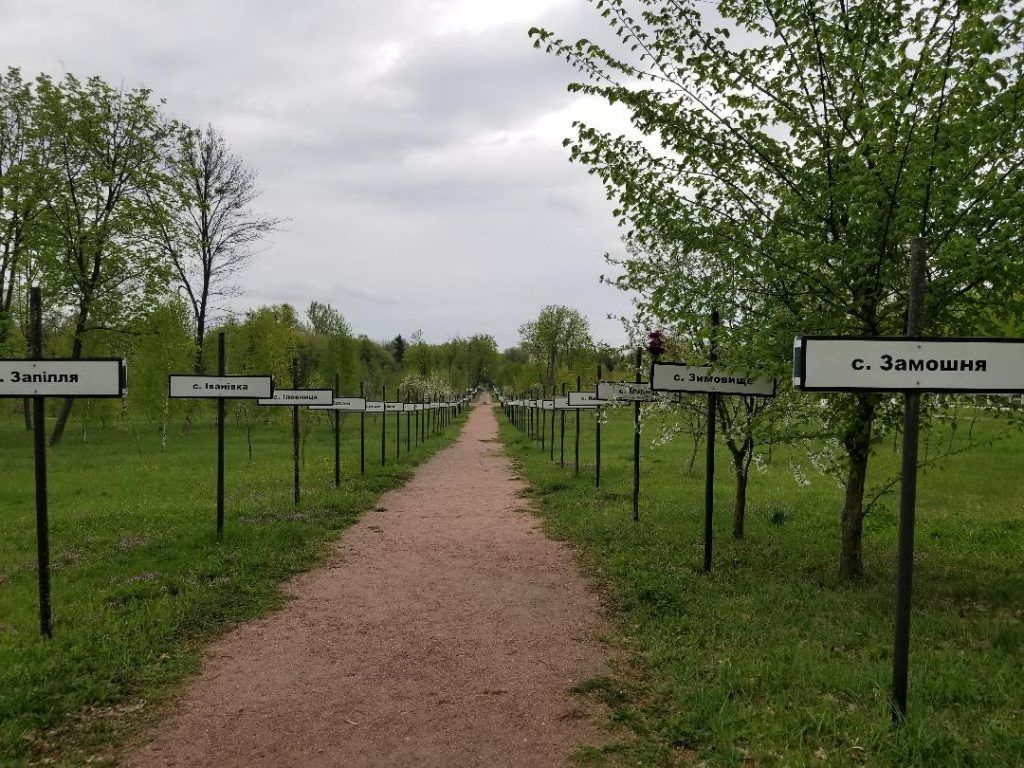Chernobyl is still changing: Four enduring stories and a recent one
By Susan D’Agostino | April 25, 2022
 Alley of abandoned villages - 162 plaques with the names of permanently evacuated settlements during 1986-1991 after the Chernobyl accident. Credit: Margarita Kalinina-Pohl (2018).
Alley of abandoned villages - 162 plaques with the names of permanently evacuated settlements during 1986-1991 after the Chernobyl accident. Credit: Margarita Kalinina-Pohl (2018).
“One of the atomic reactors has been damaged,” a Radio Moscow broadcast announced about the Chernobyl Nuclear Power Plant on April 28, 1986—nearly three days after the accident. “Measures are being taken to eliminate the consequences of the accident. Aid is being given to those affected. A government commission has been set up.”
World citizens did not know then that the event would register as the world’s worst nuclear disaster. They did not know that two plant workers had died in the explosion at Chernobyl, that 28 more would die within weeks from acute radiation poisoning, or that thousands would be diagnosed with thyroid cancer over time. They also did not know then that thousands of workers would need to continue decommissioning work at the plant for decades. And they likely could not have imagined how Chernobyl’s legacy would continue to change in dramatic ways over time.
In the 36 years since that day, nuclear experts have learned and incorporated many lessons about nuclear safety. Tourists now frequent the desolate town of Pripyat; some are respectful, others are not. A sizable radius around the plant has transformed into an ecological reserve in which animals and plants thrive. Chernobyl also now boasts a new logo. Then, last month, the beleaguered site appeared in headlines again when Russian forces seized control of the plant just days after invading Ukraine.
Since 1986, much has been written about Chernobyl—both the disaster and the place that lived on after the disaster. Below are four Chernobyl stories published in the Bulletin that have endured. The fifth story offers evidence that Chernobyl’s story may always be a work in progress.
2011: Chernobyl 25 years later: Many lessons learned
By Mikhail Gorbachev, March/April 2011
Mikail Gorbechev penned this essay on the solemn lessons Chernobyl taught the world about nuclear accident prevention, transparency, and vulnerability to terrorism and violence. He wrote: “[Chernobyl] was a horrendous disaster because of the direct human cost, the large tracts of land poisoned, the scale of population displacement, the great loss of livelihoods, and the long-term trauma suffered by individuals yanked from their homeland and heritage. … Let us all remember Chernobyl, not only for its negative impact on Ukraine, Belarus, Russia, and Europe, but also as a beacon of hope for a safer and more sustainable future.”
Chernobyl: A nuclear accident that changed the course of history. Then came Fukushima.
By Mariana Budjeryn | March 11, 2021
Mariana Budjeryn reminded readers that the Chernobyl nuclear disaster was largely seen as a result of the Soviet Union’s “backward” safety culture. But then the Fukushima disaster later happened in “an industrialized, technologically-savvy, wealthy nation with what had been regarded until that point as strong institutional infrastructures.” Budjeryn then notes that nuclear experts agree that “the question is not whether another nuclear accident will happen, but rather when it does, how prepared are we to minimize the damage and respond quickly and effectively.”
It’s not radioactive Disneyland: Visit Chernobyl, but respect it.
By Margarita Kalinina-Pohl | April 26, 2021
Margarita Kallina-Pohl looks past the kitschy souvenirs and tourists posing for selfies with Geiger counters to introduce readers to a fox named Simon who is fed by locals and lives in the 19-mile radius ecological biosphere reserve surrounding the defunct power plant. She reminds readers that Chernobyl is not a nuclear theme park but the site of the “largest anthropogenic disaster in the history of humankind.” A must-read for those interested in meaningful and respectful ways to visit.
By Julian Hayda | August 25, 2021
Julian Hayda tells the story of Banda, a Kyiv design agency, that held a 2019 company picnic in Chernobyl. Their 20 graphic designers were moved to think more deeply about the site, which then prompted them to design a visual brand for Chernobyl and its legacy.
“Banda’s logo is really a series of 78 logos—one released every year—with slices of it disappearing each year, until the image is totally gone. The logo for 1986, the year of the disaster, is a complete, black octagon. The logo for 2064 is a white void. There’s supposed to be a logo there, but it’s invisible—perhaps like radiation, which the eye can’t really see, but is nonetheless ever-present in the lives of those affected by the Chernobyl disaster.”
The changing logo “exemplifies the Zone’s movement from exclusion to rebirth and from darkness into light.” It also enables “the creation of official souvenirs that counteract the more vulgar ones.”
Russian forces now control Chernobyl, inviting speculation and uncertainty
By Susan D’Agostino | February 25, 2022
Lightning, contrary to the maxim, can and does sometimes strike twice. That’s what appeared to have happened—at least on a metaphorical level—when Russian forces seized control of the defunct Chernobyl Nuclear Power Plant last month, just days into its invasion.
As in 1986, the world’s eyes fixated on Chernobyl and the possibility of another nuclear nightmare. Though Russian forces have since relinquished control, this article captures the confusion, speculation, and concern the world experienced when war intersected with a nuclear disaster site for the first time.
Together, we make the world safer.
The Bulletin elevates expert voices above the noise. But as an independent nonprofit organization, our operations depend on the support of readers like you. Help us continue to deliver quality journalism that holds leaders accountable. Your support of our work at any level is important. In return, we promise our coverage will be understandable, influential, vigilant, solution-oriented, and fair-minded. Together we can make a difference.
Keywords: Chernobyl, Russia, Ukraine, nuclear disaster, nuclear energy, nuclear risk
Topics: Nuclear Energy, Nuclear Risk















